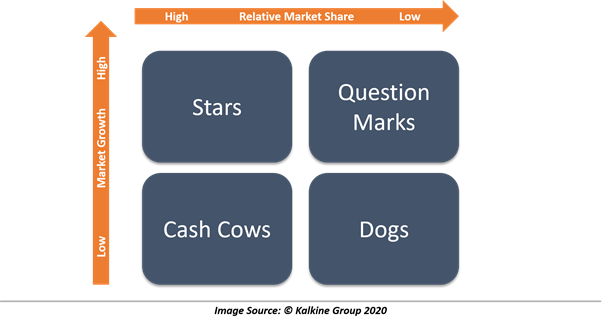What is Boston Consulting Group Matrix?
Boston Consulting Group (BCG) is a global consulting firm advising a range of industries and sectors. BCG Matrix is also known as the growth-share matrix and was developed in 1968 by Bruce Henderson, who was the founder of Boston Consulting Group.
It was published in Perspectives – BCG’s short essays. At its peak, the growth-share matrix was a mainstream metric used by large companies. The matrix helps companies to prioritise specific products, verticals or segments.
It is a table which is in four parts depicting a level of profitability to the overall company. These four parts include stars, question marks, cash cows, and pet (mostly represented by dog). Management takes crucial capital allocations after allocating products or segment to each category.
How does BCG Matrix work?
BCG Matric was developed on a notion that market leadership in categories is a source of superior returns for the firm. The market leader will, over time, develop a competitive advantage to achieve superior returns for the firm.
Meanwhile, the competitive advantages developed by the firm should be hard to replicate by the competing firms. On the vertical side of the matrix, there is growth, and relative market share is on the horizontal side of the matrix.
It helps companies to decide where to invest based on two factors: market attractiveness and competitiveness. These factors are, in turn, driven by relative market share and growth rate of the firm.
Firms also use the growth-share matrix to explore an appropriate marketing strategy for a product given its market share and growth. Since the growth-share matrix is also used for a set of products, it tends to be relevant for large organisations.
Relative market share is used to evaluate the business against the competing firms. It is widely accepted that higher market share means higher cash returns since revenues will likely be higher comparatively.
But firms would also need economies of scale to translate relatively higher revenues into higher profits. However, firms with sustainable cost advantages will likely be able to grow profits irrespective of market share.
Market growth rate means the intensity of change in revenues relative to the prior period. Firms with higher growth rates will have higher revenues, but it doesn’t necessarily mean similar growth in profits because growth comes at the cost of investments.

Businesses operating in abnormal/higher growth industries burn cash to achieve market share, and such businesses are worth when they are expected to maintain market share over the future. Now, let's discuss four quadrants.
Dogs (pets) – low market share, low growth
Since this category has a low market share and low growth rate, firms perceive that these categories are not worth investing because the returns are generally lower or even negative. Sometimes firms are inclined to keep supporting dogs due to longevity of profits, synergies for other brands, or simply competition.
When firms are inclined to keep dogs in the portfolio, it usually because the products are running on a break-even or marginal profits and could be strategically crucial for the business model. Oftentimes, these products, categories or segment are at the risk of discontinuation or divestments.
In cases when firms perceive a turnaround is possible in the pets category, it is likely that there would be reinvestment in the segments to achieve higher market share or higher growth rate.
Cash cows – low growth, high market share
Products and categories under this segment have high market share and low growth, and firms intend to push their products or categories to this segment eventually. Cash cows are highly profitable brands for the firms and should be ‘milked’ for cash generation.
The cash generated from these products gives firms better reinvestment capabilities for other products or verticals, which could become cash cows eventually. Cash used on cash cows should be for the purpose of maintaining market share.
But when cash cows are whole vertical with several products, there would be a need for reinvestments, especially in the new product development and innovation. Cash cows generate more cash than they consume and fund various capital allocation decisions like capital expenditure, debt servicing, dividends.
Stars – high growth, high market share
Products under these categories trade in high growth industries and have a high market share. They also use cash to exhibit growth and generate cash, as well. When investing back into the firms, stars are the prime targets for the management.
It is expected that stars will eventually become cash cows as growth in the industry normalises. After growth normalises in the industry, the focus of the firms turns to maintain the market share. But not all stars become cash cows.
Given the rapidly changing business landscape, innovation and development in an industry, the stars could well turn into dogs rather cash cows. Products and services that have first-mover advantage, monopoly are often considered as stars.
Question marks – high growth, low market share
Products under this category require substantial efforts of the firm. They operate in a high growth market with market share, meaning that these are usually new products in a new market with the potential to grow.
Cash generation is mostly negative under this category, and firms incur losses and burn cash to operate question marks. Since question marks are largely new products, they have the potential to become stars and eventually cash cows.
But this is also not necessarily true since question marks could turn into dogs as well. Even after huge investments and efforts, the outcome of turning into pets is detrimental for the firms.
Since the future is uncertain for question marks, the firms are required to close attention and consideration while formulating strategies for question marks.
 Please wait processing your request...
Please wait processing your request...